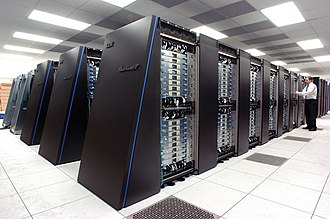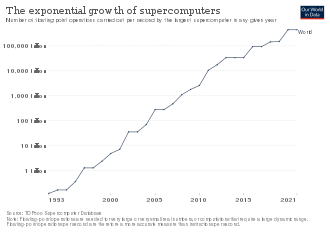
Back Supercomputer ALS حاسوب فائق Arabic Superkompüter Azerbaijani Суперкамп’ютар Byelorussian Суперкомпютър Bulgarian सुपरकंप्यूटर Bihari সুপারকম্পিউটার Bengali/Bangla Superračunar BS Supercomputador Catalan Superpočítač Czech


A supercomputer is a type of computer with a high level of performance as compared to a general-purpose computer. The performance of a supercomputer is commonly measured in floating-point operations per second (FLOPS) instead of million instructions per second (MIPS). Since 2022, supercomputers have existed which can perform over 1018 FLOPS, so called exascale supercomputers.[3] For comparison, a desktop computer has performance in the range of hundreds of gigaFLOPS (1011) to tens of teraFLOPS (1013).[4][5] Since November 2017, all of the world's fastest 500 supercomputers run on Linux-based operating systems.[6] Additional research is being conducted in the United States, the European Union, Taiwan, Japan, and China to build faster, more powerful and technologically superior exascale supercomputers.[7]
Supercomputers play an important role in the field of computational science, and are used for a wide range of computationally intensive tasks in various fields, including quantum mechanics, weather forecasting, climate research, oil and gas exploration, molecular modeling (computing the structures and properties of chemical compounds, biological macromolecules, polymers, and crystals), and physical simulations (such as simulations of the early moments of the universe, airplane and spacecraft aerodynamics, the detonation of nuclear weapons, and nuclear fusion). They have been essential in the field of cryptanalysis.[8]
Supercomputers were introduced in the 1960s, and for several decades the fastest was made by Seymour Cray at Control Data Corporation (CDC), Cray Research and subsequent companies bearing his name or monogram. The first such machines were highly tuned conventional designs that ran more quickly than their more general-purpose contemporaries. Through the decade, increasing amounts of parallelism were added, with one to four processors being typical. In the 1970s, vector processors operating on large arrays of data came to dominate. A notable example is the highly successful Cray-1 of 1976. Vector computers remained the dominant design into the 1990s. From then until today, massively parallel supercomputers with tens of thousands of off-the-shelf processors became the norm.[9][10]
The US has long been the leader in the supercomputer field, first through Cray's almost uninterrupted dominance of the field, and later through a variety of technology companies. Japan made major strides in the field in the 1980s and 1990s, with China becoming increasingly active in the field. As of November 2024[update], Lawrence Livermore National Laboratory's El Capitan is the world's fastest supercomputer.[11] The US has five of the top 10; Japan, Finland, Switzerland, Italy and Spain have one each.[12] In June 2018, all combined supercomputers on the TOP500 list broke the 1 exaFLOPS mark.[13]
- ^ "IBM Blue gene announcement". 03.ibm.com. 26 June 2007. Archived from the original on 8 July 2007. Retrieved 9 June 2012.
- ^ "Intrepid". Argonne Leadership Computing Facility. Argonne National Laboratory. Archived from the original on 7 May 2013. Retrieved 26 March 2020.
- ^ "Frontier keeps top spot, but Aurora officially becomes the second exascale machine". Top 500. Retrieved 13 October 2024.
- ^ "AMD Playstation 5 GPU Specs". TechPowerUp. Retrieved 11 September 2021.
- ^ "NVIDIA GeForce GT 730 Specs". TechPowerUp. Retrieved 11 September 2021.
- ^ "Operating system Family / Linux". TOP500.org. Retrieved 30 November 2017.
- ^ Anderson, Mark (21 June 2017). "Global Race Toward Exascale Will Drive Supercomputing, AI to Masses." Spectrum.IEEE.org. Retrieved 20 January 2019.
- ^ Lemke, Tim (8 May 2013). "NSA Breaks Ground on Massive Computing Center". Retrieved 11 December 2013.
- ^ Hoffman, Allan R.; et al. (1990). Supercomputers: directions in technology and applications. National Academies. pp. 35–47. ISBN 978-0-309-04088-4.
- ^ Hill, Mark Donald; Jouppi, Norman Paul; Sohi, Gurindar (1999). Readings in computer architecture. Gulf Professional. pp. 40–49. ISBN 978-1-55860-539-8.
- ^ "El Capitan achieves top spot, Frontier and Aurora follow behind". www.top500.org. Retrieved 19 November 2024.
- ^ "Japan Captures TOP500 Crown with Arm-Powered Supercomputer - TOP500 website". www.top500.org.
- ^ "Performance Development". www.top500.org. Retrieved 27 October 2022.